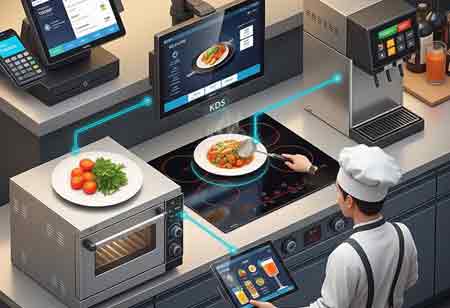THANK YOU FOR SUBSCRIBING
Be first to read the latest tech news, Industry Leader's Insights, and CIO interviews of medium and large enterprises exclusively from Food and Beverage Tech Review
Integrating POS Systems with Food Service Equipment for a Seamless Restaurant Workflow
Canadian restaurants are digitally transforming by integrating POS systems with food equipment, optimizing efficiency, enhancing customer experiences, and boosting profitability through streamlined operations and advanced technologies.

By
Food and Beverages Tech Review | Thursday, June 26, 2025
Stay ahead of the industry with exclusive feature stories on the top companies, expert insights and the latest news delivered straight to your inbox. Subscribe today.
Fremont, CA: The Canadian restaurant, characterized by evolving consumer expectations, is undergoing a significant digital transformation. At the heart of this revolution lies the integration of Point-of-Sale (POS) systems with various food service equipment, creating a seamless workflow that optimizes efficiency, enhances customer experience, and ultimately boosts profitability.
Gone are the days of disparate systems, manual order taking, and disjointed communication between the front and back of the house. Today, Canadian restaurateurs are embracing integrated solutions that act as the central nervous system of their operations, orchestrating everything from order placement to inventory management and payment processing.
The Power of Integration: A Canadian Restaurant's Advantage
Integrating POS systems with food service equipment offers significant operational and strategic advantages for Canadian restaurants. This seamless integration enhances efficiency by streamlining the order flow, automating inventory management, and optimizing labor allocation. For instance, when an order is placed through a POS terminal or an online platform, it is instantly transmitted to the Kitchen Display System (KDS), eliminating the need for manual input, reducing the risk of errors, and accelerating food preparation and delivery. I
Automated inventory tracking is another critical benefit. As orders are processed, the system updates ingredient levels in real-time, preventing stockouts of key items such as B.C. salmon or wild blueberries, minimizing food waste, and enabling timely reordering through automated alerts or supplier purchase orders. Integrated POS systems also aid in labor management by tracking employee hours, facilitating shift scheduling, and providing valuable insights into labor costs. This functionality is particularly valuable in the Canadian context, where restaurants frequently face staffing shortages and must comply with provincial labor regulations.
The customer experience is also significantly enhanced through faster service and personalized interactions. Real-time communication between the front-of-house and kitchen reduces wait times, a significant determinant of guest satisfaction. POS systems that store customer preferences and order histories allow restaurants to tailor recommendations, accommodate dietary needs, and offer customized loyalty rewards—an increasingly popular feature across the Canadian dining landscape. Integration also supports a wide range of payment options, including mobile wallets and contactless methods, catering to the evolving preferences of Canadian consumers.
Trends in Canada's Integrated Restaurant Technology
Canadian restaurants are leading the way in embracing advanced technologies, with POS integration evolving rapidly to meet the modern demands of operations. One of the most prominent trends is the adoption of cloud-based POS systems, which offer enhanced flexibility, real-time access to data, and scalability, particularly beneficial for multi-location operators and mobile business owners.
Artificial intelligence (AI) and machine learning are also reshaping POS functionality. By delivering predictive analytics on sales trends, customer behavior, and inventory management, AI empowers restaurants to make more informed decisions. Voice recognition capabilities for order entry are also emerging, pointing to a future of even more intuitive system interactions.
Mobile POS systems are further enhancing operational efficiency, enabling servers to take orders and process payments directly at the table, which improves service speed and the overall customer experience. Self-service kiosks and QR code ordering are becoming increasingly popular, streamlining the ordering process and enabling staff to focus on more strategic tasks.
The integration of Internet of Things (IoT) technologies and smart kitchen appliances with POS systems holds exciting potential. From monitoring cooking times to assessing equipment performance, these innovations promise greater automation, operational insight, and precision in kitchen management.
The integration of POS systems with food service equipment is no longer a luxury but a necessity for Canadian restaurants seeking to achieve efficiency, customer satisfaction, and sustained growth. For Canadian restaurateurs, embracing this interconnected future is the key to unlocking new levels of success.
I agree We use cookies on this website to enhance your user experience. By clicking any link on this page you are giving your consent for us to set cookies. More info







